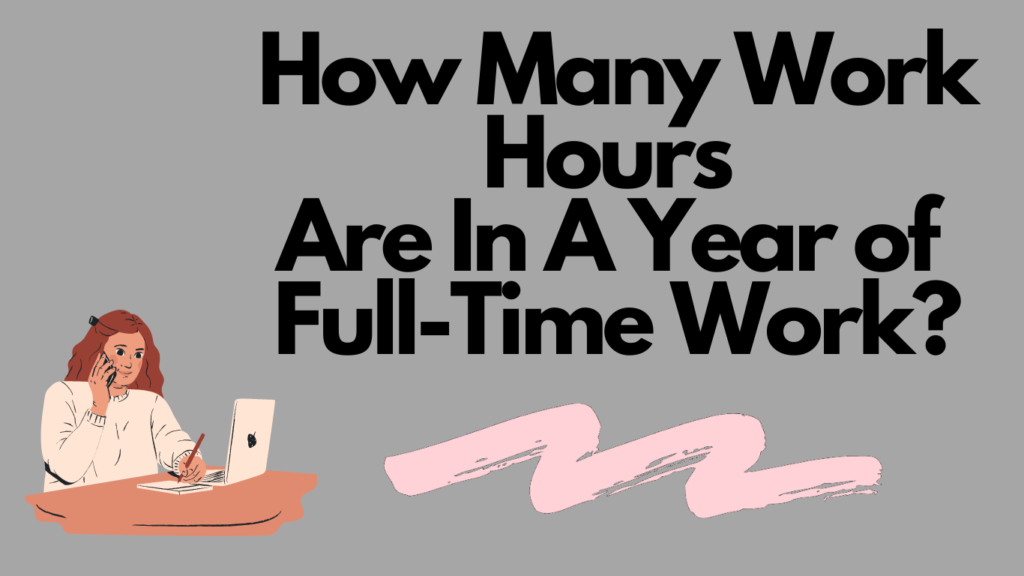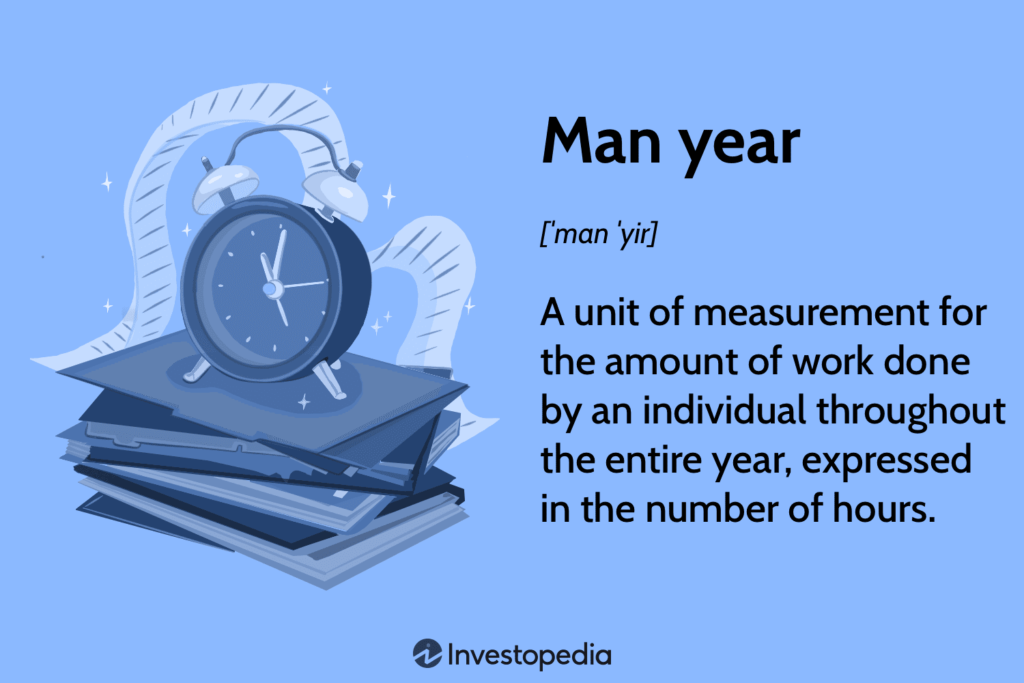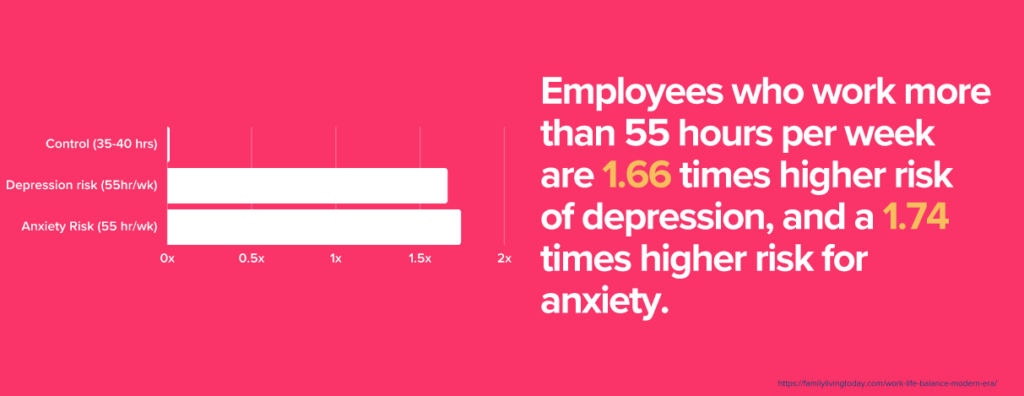How Many Work Hours Are In A Year of Full-Time Work?

Knowing how many hours people work a year seems easy to calculate, right? The answer, however, is not as simple as it seems as it depends on how you define “work year.” And before you ask: yes, there are some work years different than others.
In this blog post, we will explore different ways of calculating the number of work hours in a year and discuss the implications for workers worldwide. We will also look at recent studies on work hours and provide some interesting insights into how work time changes. Stay tuned!

Work Year or Man Year
The work year, also known as “man-year” is defined by the number of hours a person is expected to work in a specific period. This can vary depending on individual work contracts, work environment, and other factors. Generally speaking, a work year is usually 8 hours a day for 5 days a week – that means 40 hours of work per week. Multiply this by the number of weeks in a year and you get 2080 work hours in one work year.

If that calculation is the answer to “How many work hours in a year?” is quite straightforward, and that would be the end of our post. However, things get more complicated when you take into account the number of holidays, sick leaves, regional holidays, and even if the country is passing through an important event like elections.
Trends in Hours of Work: How Many Work Hours in a Year?
According to a 2020 report by the Organisation for Economic Co-operation and Development (OECD), most countries have seen an overall decrease in work hours over the last few decades. This trend is likely to continue in the near future and may even further accelerate.
Does this mean people stopped working?
Not necessarily. People just work differently. Some countries have even seen an increase in work hours due to the gig economy and freelance work becoming more popular. Therefore, this decrease in work hours has been attributed to increased job flexibility and work performance improvement. Additionally, workers are now able to customize their work environment more than ever before by working remotely or taking time off when they need it the most.
Let’s review these factors in depth!
Get more out of your business
Get the best employee engagement content every week via mailing list
Factors Influencing Work Hours
Several factors can influence work hours. These include the work environment, work schedules, work contracts, and the type of work being done.
Work Flexibility
One of the work environment factors is work flexibility. Depending on the work contract and work agreement, people may not work on a 9-to-5 schedule or work more than 40 hours a week. For example, some companies offer remote work options that allow employees to work from any location at their convenience and set their own working hours.
Freelancing is really changing the way we work, especially in the last couple of years. Freelancers can work on different projects and work any hours they like to meet deadlines. And, on the contrary belief, freelancers sometimes work more than 40 hours a week!

According to Freelancermap, in 2017, 1,386 survey participants invested an average of 47 hours per week in their work – notably higher than the traditional workweek.
Work Contracts
Another work environment factor is work contracts. Depending on work contracts, work time can be fixed or variable. For example, full-time work contracts usually require employees to work 40 hours a week while part-time work contracts may require less work time.
Additionally, some work contracts may include shift work or overtime work, which will add additional hours to the total number of work hours in a year.
Work Performance Improvement
Work performance improvement can also influence work hours. For example, tasks and work processes can be automated or streamlined which may reduce work hours in the long term.
This could result in fewer work hours, but higher work productivity. Additionally, better work organization, improved team performance, and work delegation can also result in fewer work hours.
Type of Work
Finally, the type of work being done will also influence work hours. Professional and creative jobs usually require a lot more work hours than desk jobs or work that requires repetitive tasks. Consequently, work hours will also depend on the work complexity and workload of a job.
Calculating Work Hours in a Year
Calculating work hours can be done by taking the total man-years of work and dividing it by the number of weeks in a year. This will give you an average work week. You can then get estimated work hours in a year’s figure.
Let’s help you out!
Calculate Week Working Hours
Calculating weekly working hours can be a useful exercise to conduct to gain an understanding of your own working patterns. To begin, you must determine the average number of hours you work each week.
Monitask is a great tool to track your working hours without missing a beat!
For example, if an employee works one day less than the previous example but with increased daily work hours, they would have worked 36-week working hours that week. It is important to accurately track weekly working hours as it helps ensure labor law regulations are met and all employees are fairly remunerated for their time worked.
Multiplication by 52
Once the work hours for a week have been calculated, by multiplying this number by 52, as there are 52 weeks in a year, you get a rough estimate of the annual total that can be reached. It is worth noting, however, that this appraisal does not consider vacation days and any other holidays taken in the year.
To accurately calculate the number of hours worked in a week, employers should factor in these days off to get an even more precise idea of employee activity throughout the week.
Calculate Paid Time Off Hours
Once you have established how your paid time off hours are allocated, you can calculate the total number of paid time off hours that you spend out of the office each year. For instance, if your organization separates paid time off into sick time and vacation days, you should include the total vacation days used or an estimate of the amount of time spent on sick leave each year.
However, if paid time off covers all paid absences from work, simply take the total allotted PTO hours and subtract it from a typical working year which typically spans 2,080 hours to determine the exact number.
Calculate Your Paid Holiday Hours
Depending on your situation, this could be a predetermined number or based on special circumstances like if certain major holidays fall on a weekend day.
Once that is determined, simply multiply it by the number of hours you work in a single day; for example, if you receive 10 paid holidays per year and your job requires 8 hours a day, you end up with 80 paid holiday hours in total.
Sum Everything Up!
When summing up all of the total hours you get for paid time off, you must add the allocated PTO hours to the total number of paid holiday hours. For example, if you received 160 PTO hours and 80 paid holiday hours, this would sum up to a total of 240 paid work-free hours. It is important to know that this is just an estimate as not everyone may take full advantage of all the given time away from work.
Deduct Total Time Off from Annual Hours
By completing steps two and five, we reach the formula:
Total hours in a year = (# hours per week x 52) – [(# of days of PTO + # Paid holidays) x # Hours per day].
Subtracting your total time off from your original working hours gives us a “bigger picture” of how much time is actually spent working each year, versus being away on paid holiday or personal time off. Keeping track of the number of hours spent absent from work gives us an accurate representation of the amount of working time left in each given year.
And, that’s it! Fairly easy. Yet, why is this important? Knowing average hours worked allows us to have a glimpse into the status of work-life balance.
The Importance of Knowing Your Total Worked Hours Per Year
Learning to know how many work hours you or your employees are putting in each year helps to achieve a better, more conscious workplace.
Good Work-Life Balance
Knowing your annual work hours is an important step in creating a successful and equitable workplace. When employees are well aware of their total hours worked in a year, they can achieve better work-life balance.

Good work-life balance helps promote physical and mental well-being, productivity, and satisfaction which align with the goal of any organization. Furthermore, reflecting on the number of work hours that have been logged shows an appreciation for the hardworking staff and can result in higher engagement and loyalty.
Calculating your total worked hours per year keeps workers motivated and prevents burnout so that companies can stay competitive in their respective industries.
Fair Remuneration
Fair remuneration and successful businesses go hand in hand, and having the total number of hours each worker is putting in during the year is key to this equation. Knowing your total worked hours per year allows employers to ensure that their workers are being compensated appropriately for the time they provision, enabling and encouraging employees to work more conscientiously, efficiently, and safely.
For example, abiding by the Fair Equal Remuneration Act of 1976 is significant in terms of fair pay as it prohibits any discrimination between men and women for remuneration or other conditions and privileges of employment. This ensures fair pay for equal work regardless of the gender, marital status, or family responsibilities of the individuals.

It also ensures that businesses are investing employee resources in an appropriate manner for maximum returns. Consequently, by keeping a close eye on the total worked hours of individuals, employers can make well-informed decisions that will benefit both them and their staff.
Labor Regulations
When you know your employee’s total work hours per year is integral for businesses to abide by labor regulations and create a conscious, healthy workplace. Labor regulations provide protection to employees, so it is in the best interest of employers to ensure they are kept up-to-date.
Knowing the exact amount of time that has been worked has a significant impact on total wages, overtime pay, workers’ rights, and benefits and enables business owners to make smarter budgeting decisions alongside more meaningful changes in the workplace atmosphere.
Increase Productivity
Maintaining an accurate log of the amount of time everyone is investing in a certain job gives an idea of how efficiently work is being produced. If one notices too many hours without enough output, one can adjust work schedules accordingly and assign tasks appropriately to raise the overall productivity of the workplace.
Furthermore, being aware of the annually worked hours can prove useful when carrying out motivational assessments or allocating incentives or bonuses in customer-related jobs where wages are based on performance. Keeping track of employee workload also helps determine realistic working conditions that can be set while considering safety measures.
Final Considerations
When it comes to working hours, everyone should be mindful of the amount of work they are doing as overworking can lead to a decrease in overall productivity due to fatigue and stress.
To calculate the total work hours in a year, one must begin by taking into account any work schedule policies that are in place in the workplace. These could include:
- Paid time off (vacation days, sick leave, and parental leave)
- Working hours for weekends or holidays
- Overtime pay for work done beyond the set work hours
- Overtime pay for work done on holidays
After considering this guideline, you can then begin calculating the total work hours per year and adjust their work schedules accordingly and optimize work performance. Use Monitask to gain better insight into the productivity levels of your workforce!
-The Monitask Team


